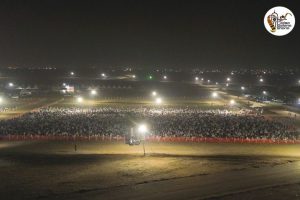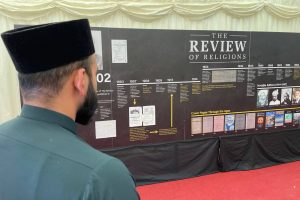
On a rainy weekend in July, thousands of Muslims gathered in Hampshire, dodging mud slicks and donning wellies across a 200-acre farmland temporarily transformed into a tent village, all headed to a three-day annual convention organised by the Ahmadiyya Muslim Community.
But in the midst of this tented village, in a small round dome straddling the separate areas for men and women, a subset of the Muslims attending the larger event are captivated by Barrie Schwortz’s presentation on the Shroud of Turin, as he describes the image like a negative.
So why is Schwortz, who is Jewish, discussing a Christian relic at a Muslim conference?

AMA UK Gallery
Welcome to the Shroud of Turin Conference—an annual conference put on by The Review of Religions to bring together scholars from around the world to talk about the Shroud of Turin: an extensively researched relic in the history of Christianity. The Shroud is a most debated strip of cloth which appears to bear an image of Jesusas, one of the most well-known religious figures in history. Over the centuries, this piece of linen, bearing the faint imprint of a man, has been the subject of intense speculation.
Held concurrently with the larger convention of the Ahmadiyya Muslim Community, the 2017 Shroud of Turin conference organised by The Review of Religions was a more intimate affair, bringing together scholars, long-standing members of the Shroud community, and interested members of the Ahmadiyya Muslim Community to discuss all aspects of the Shroud. With a lineup including historian Mark Guscin, photographer Barrie Schwortz, filmmaker David Rolfe, and scholar Bruno Barberis, the Shroud conference covered various aspects of the Shroud of Turin, a cloth that is now revered by millions of people because it is believed to have been the burial cloth that Jesus of Nazarethas was wrapped in after his crucifixion. By that token, the Shroud of Turin is believed to be a sacred and blessed relic not only by millions of Christians, but also by Muslims who hold Jesusas in deep regard as a noble Prophet of God.

The Review of Religions
But what evidence is there for the theory that the Shroud is in fact the cloth that Jesusas was wrapped in after his crucifixion? The experts presented various theories and findings. As former President of the Scientific Committee of the International Centre of Sindonology of Turin and former Director of The Shroud of Turin Museum, the attendance of Bruno Barberis was an important landmark for the short history of the Shroud of Turin conference. Barberis, as one of the officials responsible for preserving the Shroud, has direct access to it and so provided an insight into the history of the Shroud. In his talk, Barberis explained that the Gospels mention that Jesusas was wrapped in a cloth of some kind before being arranged in the tomb. The Shroud, measuring 4.4 metres long and about 1.1 metres wide, is linen and has four different kinds of marks on it: fire marks, from a fire that broke out in France in 1532; water stains, surmised to be from the water used to put out that fire; blood stains; and the imprint of a human figure that was wrapped in the cloth.
For centuries, there was little progress on the scientific side of Shroud research. But the advent of photography made the Shroud famous worldwide, and opened new avenues of research. In 1898, the first public exhibition of the Shroud also led to the first photographs of the Shroud, with the photographer, Secondo Pia, mentioning how much the Shroud image resembled a negative of a photograph. While a negative image reverses the features of the person, a negative of the Shroud image results in, as it were, a positive image, showing us the man as he stood before us. Indeed, Pia said that when he saw the picture it was as though he ‘was looking into the face of the Lord.’

The Review of Religions
This development was only the beginning: the next century would see progress on many fronts in Shroud research, culminating in a five-day research mission in 1978, inspired by the fact that a tool called the VP–8 image analyser was able to process a unique 3-dimensional image on it. Why was this significant? As photographer Barrie Schwortz explained during his talk, the VP–8 image analyser is used to examine the light and dark areas in an image, and, using this information, can create a proportionate three-dimensional image. But photographs of humans, when processed by the VP–8 analyser, don’t carry enough information for the machine to create a natural relief of the human form. But images of the Shroud, when put through the VP–8 analyser, did create a natural relief of the human form, indicating that the Shroud was not a photographic image (as some theories have suggested).
Given this intriguing development, a research team was put together to go to Turin and examine the Shroud thoroughly. In 1978, photographer Barrie Schwortz had just wrapped up a contract working as a photography consultant at Los Alamos labs. Several weeks later, the same contractor contacted him, asking if he’d be interested in the Shroud project. There began a lifelong fascination and passion for Schwortz. As one of the documenting photographers, Schwortz was responsible for photographing the entire process of the research mission—a five-day research marathon that is the most thorough analysis of the Shroud to date.

Makhzan-e-Tasaweer
But how do you begin to analyse a cloth that could be 2000 years old? Very carefully. Over 17 months of planning went into the trip, and they scheduled their five-day trip down to the minute. The detail involved: inside one of the over 80 equipment crates that the team brought with them was a special table to lay the Shroud on, so that it could be held in place with non-invasive magnets; a specially designed camera rail so that they could photograph the Shroud in sections, keeping the distance exactly the same so that they could perfectly match up the photographs later to get a complete picture; and two rolls of gold foil mylar, the material used on satellites, which came in handy after they found out that the steel on the special table had corroded and that they would need to lay something else on the table before putting the Shroud on it.
Yet another example of the planning involved: the magnets used to hold the Shroud in place on the table were coated in Teflon, so that no magnetic particle would touch the Shroud. The head of the chemistry team went to the company 3M (makers of the Post-its and sticky notes you might use on your billboard at home) to make a special tape that would not leave residue on the Shroud.

So what were the conclusions of the trip?
While the researchers weren’t able to discover what had caused the image, they were able to rule out what hadn’t: the image was not a photograph, not a painting, not a conventionally-produced image. What exactly has caused the image, though, is still a mystery.
While many have heard of the Shroud of Turin, not as many have heard of the Sudarium of Oviedo. Yet, this smaller head cloth has a deep link with the Turin Shroud. The Shroud of Turin Conference in 2017 marked the first year the Sudarium of Oviedo was featured. Historian Mark Guscin, an expert linguist and world-renowned researcher on the Sudarium, attended in person and addressed the conference on the second day. Guscin related in his session that the Sudarium, or head-cloth, was housed in the Cathedral of Oviedo, in Spain, which has a special room that houses various relics, many of them not authentic, but which also held the Sudarium—a seemingly nondescript cloth that ostensibly has no connection to the Shroud of Turin.
Indeed, the cloth was considered so insignificant that there was no serious research on it until the 1980s. But once it was analysed, the Sudarium—a low-quality piece of fabric typically carried in Roman times to wipe one’s face of sweat and grime—was found to have been folded and creased many times, but more significantly, to have blood stains and blood mixed with pleural edema fluid—that is, the fluid that collects in the lung during asphyxiation, suggesting that the person whose blood was on the cloth died of asphyxiation. The top stains on the Sudarium correspond with the lips. Indeed, Guscin says that, ‘the hair was so matted with blood that it was actually almost solid, and this cloth was pinned onto that.’ Indeed, when researchers tried to recreate the stains with a model head and the same fluid, they found that the only way that the initial stains could have been made was if the head were in an upright position with the arms stretched out, head leaning to the right, for about 45 minutes to an hour. While this isn’t incontrovertible proof that the body linked to this cloth was crucified, it is certainly compatible with crucifixion.
So the person whose blood is on the Sudarium may have been crucified. But there is more evidence that the Sudarium is connected to the Shroud. For one thing, the blood group of the blood on the Shroud and the blood on the Sudarium are the same. Moreover, the life-blood (blood shed while the victim was alive) and the blood shed post-mortem are both the same on each cloth. In addition, some blood stains on the left side of the cloth, which correspond to the nape of the neck, match up on both the Shroud and the Sudarium, leading to the intriguing conclusion that the two cloths, having journeyed to different places, come from the same origin.

The Review of Religions
After four highly informative sessions in which speakers presented on different aspects of the Shroud, interacted with knowledgeable guests from the Shroud community, and answered questions from the guests, the conference culminated in a lively question-and-answer session, largely with an audience of the women of the Ahmadiyya Muslim Community. The question-and-answer panel consisted of Barrie Schwortz, Pam Moon (who brought a life-size replica of the Shroud), David Rolfe, Bruno Barberis and Hugh Farey (former editor of the newsletter for the British Society of the Turin Shroud). A honourable and learned scholar of Christianity from the Ahmadiyya Muslim Community, who had travelled from Rabwah, Pakistan, Mir Mahmood Nasir Ahmed, also attended the Q&A. Mir Mahmood Nasir Ahmed has led the team of researchers working on experiments to try and re-create the image of the Shroud upon a cloth through coating a living body with a special ointment, known as the ‘marham-i-Isa’ or ‘Ointment of Jesus’, and bringing this body in contact with the cloth. This ointment was highlighted by Hazrat Mirza Ghulam Ahmadas, founder of the Ahmadiyya Muslim Community, in his treatise, Jesus in India in 1899, and described as the ointment applied to the wounds of Jesusas, following the Crucifixion. Mir Mahmood presented a copy of his research and samples of the ointment to all the esteemed speakers and the Q&A kicked off with the first question from Mir Mahmood, asking why the Shroud community had not pursued a similar line of enquiry to his, given some documented success of re-creating an image using mixtures of aloe and myrrh on linen.
One feature that brought the Q&A session alive, was that it took place directly in front of Pam Moon’s wonderful exhibition boards, covering the Shroud and aspects of it. The centrepiece of Pam’s exhibition is a full life-size replica of the Shroud. Pam has tirelessly brought this exhibition down from her home in the Midlands each year, and once more brought along her team of Shroud experts to help explain the details of the cloth to the visitors of the exhibition.
One of the most interesting aspects of the conference was the surprise felt by many of the speakers that attendees of a Muslim convention would be so interested in a Christian relic. In particular it was noted by the speakers how the women of the Ahmadiyya Muslim Community were very interested and asked many questions; they expressed that even on their visits in Turin they have never faced such a bold audience willing to openly ask questions and persist until they recieved the answers. Yet the Shroud of Turin, with its fascinating history, religious significance, and unsolved mystery, has united people from all walks of life during the international conference.
……………………………………………………….
About the Author: Nakasha Ahmad was previously an Adjunct Lecturer at Eastern Michigan University and a Graduate Assistant at Bowling Green State University. She currently serves as the Associate Editor of The Review of Religions.
…………………………………………………………….




Add Comment